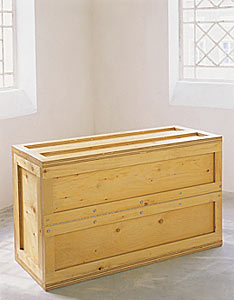
Born in 1957 in Harare (ZW)
Lives and works in London (GB)

1991
Plastic and wood
67 x 116 x 47 cm
Year of Purchase: 1995
As far as the place where any art object finds itself, per force, there are three possible attitudes. Either total indifference; the work neither seeks to be listed in its site, nor displays its freedom with regard to this site – this is the attitude of most art objects presented. Or, the work may decide to link itself to the place in which it becomes visible. Or, alternatively, the work may choose to assume its mobility, and either glorify it or display it.
It is this attitude, the way the artwork takes its mobility into account, which hallmarks, Stephen Hughes’ Container using a method which is both simple and spectacular: the art object is exhibited in the container which allows it to travel.
Described here we see, on the one hand, a structural mobility, based on which the object is in no way assigned to a precise place in space. The meaning of the work is thus the following: if the art object is not affected by some relevant overdetermination, it is as a result mobile, free of any local attachment, and it is its duty to display this freedom. But, with the Container, we see described, on the other hand, a situational mobility based on which art objects move from one place to another, at the whim of their impressive or commercial existence.
The journey promised by Hughes’ container is nevertheless not only one which leads from one exhibition venue to another. It is also the journey which leads from the exhibition venue to the museum’s stocks, or the stocks of a gallery or collector. The container is not just the means of transit, it is also a means of storage.
What is suggested by the Container is that the most likely fate of the artwork is not its exhibition, but its storage in a crate, in the depths of a storage area. Curators would not contradict Hughes on this point.
Lastly, if we are aware that the understanding of the meaning of a sign has often been depicted as a shift of a container to a thing contained, the Container, solely insomuch as it presents a container – which the viewer is allowed to open and close – and a thing contained, can work like the emblem of a semiotic act.
But the nature of the content put on view by the open container leads onlookers to wonder if it is not best to see, in the Container, just the simple designation of the semiotic status of the artwork. In fact, the yellow plastic objects challenge any conclusive understanding. These artefacts are difficult to exchange against anything ideal, stripped of that utilitarian purpose which some of their features appear to endow them with, resistant to stylistic characterization; their essential function seems to be to thwart interpretative capture.
Doesn’t the Container suggest something else? This, for example: what we can be sure of, given that this is an artwork, is that it is about something; knowing what it is precisely about is quite another story, so, in any case, the truth of the matter, assuming it is worth knowing, does indeed risk being ambiguous.
Michel Gauthier